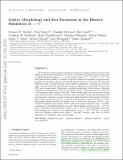Galaxy morphology and star formation in the Illustris Simulation at
Author(s)
Snyder, Gregory F.; Lotz, Jennifer M.; Genel, Shy; McBride, Cameron K.; Pillepich, Annalisa; Nelson, Dylan; Sales, Laura V.; Sijacki, Debora; Hernquist, Lars; Springel, Volker; Torrey, Paul A.; Vogelsberger, Mark; ... Show more Show less
DownloadGalaxy morphology and star.pdf (12.02Mb)
OPEN_ACCESS_POLICY
Open Access Policy
Creative Commons Attribution-Noncommercial-Share Alike
Terms of use
Metadata
Show full item recordAbstract
We study how optical galaxy morphology depends on mass and star formation rate (SFR) in the Illustris Simulation. To do so, we measure automated galaxy structures in 10 808 simulated galaxies at z = 0 with stellar masses 10[superscript 9.7] < M*/Mȯ < 10[superscript12.3]. We add observational realism to idealized synthetic images and measure non-parametric statistics in rest-frame optical and near-IR images from four directions. We find that Illustris creates a morphologically diverse galaxy population, occupying the observed bulge strength locus and reproducing median morphology trends versus stellar mass, SFR, and compactness. Morphology correlates realistically with rotation, following classification schemes put forth by kinematic surveys. Type fractions as a function of environment agree roughly with data. These results imply that connections among mass, star formation, and galaxy structure arise naturally from models matching global star formation and halo occupation functions when simulated with accurate methods. This raises a question of how to construct experiments on galaxy surveys to better distinguish between models. We predict that at fixed halo mass near 10[superscript 12] Mȯ, disc-dominated galaxies have higher stellar mass than bulge-dominated ones, a possible consequence of the Illustris feedback model. While Illustris galaxies at M* ∼ 10[superscript 11] Mȯ have a reasonable size distribution, those at M* ∼ 10[superscript 10] Mȯ have half-light radii larger than observed by a factor of 2. Furthermore, at M* ∼ 10[superscript 10.5]–10[superscript 11] Mȯ, a relevant fraction of Illustris galaxies have distinct ‘ring-like’ features, such that the bright pixels have an unusually wide spatial extent.
Date issued
2015-12Department
Massachusetts Institute of Technology. Department of Physics; MIT Kavli Institute for Astrophysics and Space ResearchJournal
Monthly Notices of the Royal Astronomical Society
Publisher
Oxford University Press
Citation
Snyder, Gregory F.; Torrey, Paul; Lotz, Jennifer M.; Genel, Shy; McBride, Cameron K.; Vogelsberger, Mark; Pillepich, Annalisa et al. “Galaxy Morphology and Star Formation in the Illustris Simulation Atz = 0.” Monthly Notices of the Royal Astronomical Society 454, no. 2 (October 8, 2015): 1886–1908.
Version: Author's final manuscript
ISSN
0035-8711
1365-2966